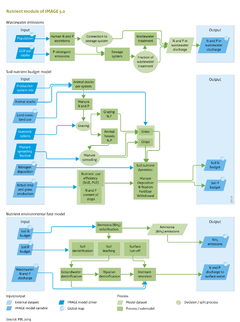Nutrients/Description: Difference between revisions
Jump to navigation
Jump to search
No edit summary |
No edit summary |
||
| Line 6: | Line 6: | ||
{{FormulaAndTableTemplate|Formula1_N}} | {{FormulaAndTableTemplate|Formula1_N}} | ||
where is human N emissions (kg per person per year), D is the fraction of the total population that is connected to public sewerage systems (no dimension), | where | ||
*is human N emissions (kg per person per year), | |||
*D is the fraction of the total population that is connected to public sewerage systems (no dimension), | |||
*R N is the overall removal of N through wastewater treatment (no dimension). | |||
Total P emissions to surface water are calculated in a similar way, but also include estimates of P emissions to surface water resulting from the use of P-based dishwasher and laundry detergents. Nutrient removal by wastewater treatment R is based on the relative contribution of four classes of treatment (none, primary, secondary and tertiary treatment). D (calculated from the fraction of households with improved sanitation) and R (by treatment class) are scenario variables. | |||
==B. Soil nutrient budget model== | ==B. Soil nutrient budget model== | ||
The soil budget approach ([[Bouwman et al., 2009]]; [[Bouwman et al., 2011]]) includes the N and P input and output for IMAGE grid cells. Soil N budgets are calculated for two production systems (see figure on the right, B.), i.e. mixed and pastoral livestock production systems ([[Livestock]]). N input includes application of synthetic N fertiliser ( | The soil budget approach ([[Bouwman et al., 2009]]; [[Bouwman et al., 2011]]) includes the N and P input and output for IMAGE grid cells. Soil N budgets are calculated for two production systems (see figure on the right, B.), i.e. mixed and pastoral livestock production systems ([[Livestock]]). N input includes application of synthetic N fertiliser (Nfert) and animal manure (Nman), biological N fixation (Nfix), atmospheric N deposition (Ndep). Output includes N withdrawal from the field through crop harvesting, hay and grass cutting, and grass consumed by grazing animals (Nwithdr). The soil N budget (Nbudget) is calculated as follows: | ||
{{FormulaAndTableTemplate|Formula2_N}} | {{FormulaAndTableTemplate|Formula2_N}} | ||
For P the same approach is used, P input being animal manure and fertiliser. The soil nutrient budget ignores nutrient accumulation in soil organic matter in case of a positive budget (surplus), and soil organic matter decomposition and mineralisation. With no accumulation, a surplus represents a potential loss to the environment (for N this includes NH3 volatilisation ([[Emissions]]), denitrification, surface runoff and leaching; for P this is surface runoff). | For P the same approach is used, P input being animal manure and fertiliser. The soil nutrient budget ignores nutrient accumulation in soil organic matter in case of a positive budget (surplus), and soil organic matter decomposition and mineralisation. With no accumulation, a surplus represents a potential loss to the environment (for N this includes NH3 volatilisation ([[Emissions]]), denitrification, surface runoff and leaching; for P this is surface runoff). | ||
Revision as of 15:23, 17 December 2013
Parts of Nutrients/Description
| Component is implemented in: |
| Components: |
| Related IMAGE components |
| Projects/Applications |
| Key publications |
| References |
